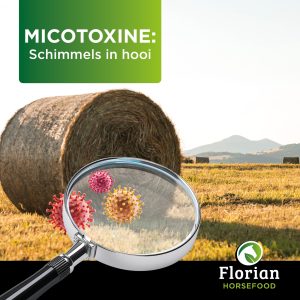
There are fungi all around us.
You have healthy fungi, which help digest food or produce beneficial substances.
But you also have harmful fungi.
Some of these harmful fungi produce micotoxins.
Micotoxins are toxins and are a creeping danger to your horse’s health.
In this blog, we dive deeper into the world of micotoxins, their impact on horses and important preventative measures to keep our four-legged friends safe.
Micotoxins are toxins produced by fungi.
These potentially dangerous substances can occur in feed and hay that horses eat, posing a risk to animal health.
Understanding micotoxins is essential to ensuring the health of horses.
Mold spores – the seeds of fungi – are all around us.
When hay still contains too much moisture is when ‘r packages are made of it or when the hay is exposed to moisture in storage, these spores can germinate and fungi can grow in the hay.
As a defense mechanism, these fungi then produce mixotoxins.
Fungi can also grow in packed hay, also called haylage.
Mold requires a combination of moisture and oxygen to grow.
If a pack is not properly airtight, oxygen can enter the pack and fungi can grow.
Other feed products your horse eats may also contain fungi containing micotoxins.
Examples include grains, seeds or herbs that are incorporated into mueslis or concentrates.
But even on fresh grass, fungi can grow and thus develop micotoxins.
Especially in spring and fall, when the grass is wet from rain or dew, fungi can grow in the grass.
Exposure of horses to micotoxins can lead to a range of health problems, ranging from digestive problems to neurological disorders.
Symptoms of micotoxin poisoning in horses include: decreased appetite, weight loss, decreased performance, flu symptoms, skin problems, coughing and liver problems.
The effect of micotoxins on the liver of horses can be significant because of the specific way these toxins affect the digestive system and liver.
When horses ingest micotoxins, these substances can be transported to the liver through the bloodstream.
In the liver, micotoxins can directly damage hepatocytes (liver cells) and cause inflammatory reactions.
This can lead to liver damage and disruption of normal liver function, which can affect metabolism and detoxification in the body.
Therefore, it is especially important to prevent active micotoxins from reaching the liver.
And in after micotoxin poisoning, we will need to support the liver to recover.
Detecting fungi in hay can be tricky.
It is possible to have your hay tested in the laboratory, but this is a fairly costly affair.
Especially with low contamination, it can be difficult to determine if the hay is moldy.
Characteristics of moldy hay include: a musty smell, feeling damp or sticky, dusty and a white or grayish deposit on the hay.
When you feed dry, unpackaged hay, proper storage of your hay is crucial.
Fungi can only begin to grow when there is sufficient moisture in the hay.
This moisture can get into your hay in several ways
1) during the making of the hay
2) during storage.
Packaged hay or haylage always contains more moisture in the roughage.
If the pack is then inadequately sealed or if holes appear in the plastic, oxygen can enter the pack and mold can grow.
Make sure your hay is thoroughly dry before packing.
A minimum dry matter content of 80% to 85% goes a long way toward reducing the chances of mold growth.
In addition, the packs should not be packed too tightly.
In very tightly packed packs of hay, any moisture left in the grass/hay cannot escape properly.
Also, don’t leave the packs in the field (too long).
One shower of rain on your fresh bales of hay, can be enough for mold to grow.
When you store hay, it is very important that your hay remains free of moisture.
Make sure the hay is off the ground by placing it on pallets, for example.
Also, always check the roof.
Not only can a leaky roof bring moisture into your hay, but condensation moisture on the roof can run into the hay and cause major problems.
Also, don’t store your hay in the same room where there are many horses (or other animals).
The exhalation of each animal always brings moisture with it.
This moisture can precipitate on the hay and cause mold there as well.
When your horse gets haylage, storage is a little easier.
Because suit is packed air and watertight, moisture ingress is not a problem.
However, holes may develop in the plastic, due to pests or during transport of the suit.
So make sure you have good pest control and reseal holes as soon as possible.
If your horse does contract micotoxin poisoning, always consult your veterinarian.
In the long run, you can support your horse by feeding healthy products that help your horse’s liver eliminate these micotoxins.
In addition, it is possible to feed micotoxin binders that trap and render micotoxins harmless during the feed digestion process.
Micotoxin binders added to horse feed can help neutralize micotoxins in the digestive system of horses.
By adhering to micotoxins and rendering them harmless, these binders can reduce the effects of micotoxins and protect horses’ health.
For this reason, we add micotoxin binders to our products.
This gives you an extra assurance that your horse is always protected, should it come into contact with micotoxins.
Understanding micotoxins and related preventive measures are vital for horse lovers and caregivers.
By being aware of the impact of micotoxins, implementing preventive strategies and treating micotoxin poisoning correctly, we can optimize the health and well-being of our beloved horses.
The world of micotoxins is complex, but with proper knowledge and careful measures, we can protect equine health and create a safe nutritional environment for these noble animals.
Author: Pieter de Gouw, Animal Scientist
Discount Applied Successfully!
Your savings have been added to the cart.